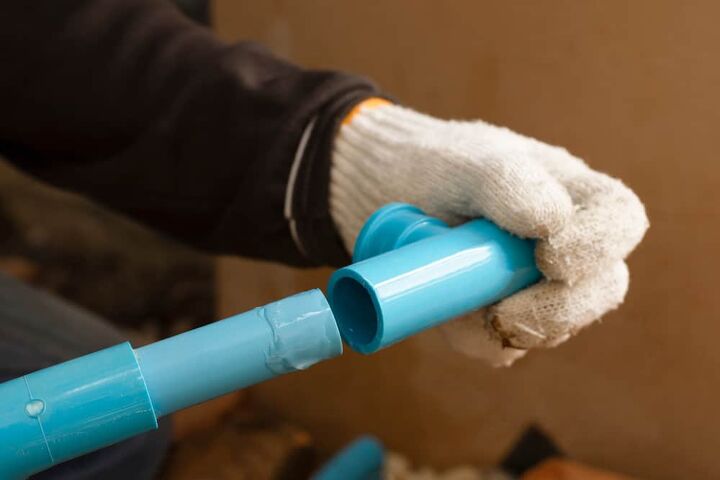How Long To Wait After Gluing PVC Pipe (Find Out Now!)

Plumbing can be a quick and easy process when all you are doing is gluing PVC pipes together. Two different lines are used in plumbing, PVC, and CPVC. PVC is for regular water only, and CPVC is for hot and cold.
The hardest part of putting the lines together is digging the trenches if needed. Everything else is gluing and fitting the pieces together. One question is, how long does it take before you can turn on the water?
Wait 2 hours to turn on the water after you glue PVC pipes. The pipes won’t be able to handle the water pressure before then, and water will weaken the bond. The adhesive hardens within 15 minutes, but it doesn’t generally cure until 2 hours have passed.
The Different Types of Adhesives in Plumbing
One thing you will learn quickly is PVC pipe fits together with a snug fit by itself. However, there are different types of adhesives used to keep the pipes together under pressure. It is essential to know what and when to use each one for various purposes.
There is the purple primer, heavy-duty cement, pipe joint compound, and PVC thread tape. There are four different things to consider before beginning a do-it-yourself project.
- What is your purpose in using PVC pipes?
- What type of pipes are you using (CPVC, PVC, or CTS)?
- Are there codes and regulations for your goals?
- Is there a threaded end or slip-on connection to the pipes?
The Primer
The primer comes in different colors but is mainly sold in purple. The reason it is colored is that it shows up as proof when codes are required that it is placed. It serves as a cleaner and preps the pipe for the glue or cement.
PVC Heavy Duty Cement
Once the primer is on, the cement is placed around the connection areas of the pipes. There is a 15 to 30 second time limit to connect the pipes. The cement dries quickly within two hours and, after it cures, cannot be broken.
There is a chemical inside the cement that melts the PVC pipe connections together. A better way to describe it would be by welding the connections.
PVC Joint Compound
This adhesive is more like glue and will hold the pipes together. It is not as firm as the cement, but the connections can be removed by force. The compound is the glue to use when the pipes are not meant to be permanent.
PVC Thread Tape
The purpose of the tape keeps leaks from occurring at the threaded connection. It helps keep the pipes from corroding and helps keep them together. The proper way to apply is over the male threads a couple of times and screw the female connection into place.
What is Your Purpose?
PVC pipes have many purposes inside the realm of plumbing. They also have other purposes that the creative mind can only fathom. PVC pipes have been used for fences, small posts, exhaust systems, crafts, and other things.
Once the goals are determined, you can figure out which adhesive is suitable. If you set up a sprinkler system for the kids, you do not want to use cement. After summer is over, your only option is to cut the pipes if cement is used.
The Type of Pipes You are Using
The purpose will determine what type of pipes you will need. PVC is the white pipe, and CPVC is cream-colored or a light gray. CTS is copper, and each has its specifications written on it.
CPVC and CPVC CTS pipes can withstand water temperatures up to 180 degrees Fahrenheit. If no hot water is used, regular PVC is sufficient.
Codes and Regulations for the Pipe
It depends on the purpose and uses for the pipes if there will be any codes and regulations to follow. Most plumbing has codes, so it is critical to check with the municipal government to find out. Sometimes there may have to be inspections to take place.
Threaded End or Slip-on Pipes Make a Difference
Threaded ends have a male and female connection with threads. Cement is out of the question as it will destroy the threads on PVC pipes. The threaded tape would be appropriate for the male fitting.
Slip-on connections most commonly take primer and cement. There the joint compound adhesives available, but cement is the one most people choose. Once the cement dries, you cannot separate the connections.
The Difference Between Cement and Compound
There are a few things to note when using cement or compound. Both hold PVC pipes together but in a different way. These are the differences.
Cement
Cement is a chemical that dries with a tight bond that cannot break. It melts the PVC together, and the two attachments become one. Once the cement is on the connections, the only way to remove the pipes is to cut them.
Cement works excellent also for fixing hairline cracks because it fuses the gap, closing it.
Joint Compound
Once this adhesive is in place, it swells up to prevent leakage. The entire connection must have the application, or there will be a leak. People use the compound to remove the pipes at a later date by twisting with force.
How to Connect PVC Pipes
Some people never had the opportunity to put PVC pipe together. It is one of the simplest DIY tasks anyone can ask for in plumbing. At some points, you may even feel like it is magic.
These are the steps to follow when putting PVC pipe together for running water.
Step 1: Measure and Cut the PVC Pipe
Take a tape measure and calculate how much PVC pipe is needed for the job. You may not need the entire length of the last pipe, so you will need to cut it. A hacksaw works best for cutting PVC.
Other parts of the line may need 90 or 45-degree angles. You will need to cut the pipe accordingly to fit these turns in the line. PVC Pipe cutters are also used if a hacksaw is not available.
Once the pipe is cut, take a file or sandpaper to file off the fringed ends. These small pieces will get in the way as you are putting the pipes together and gluing them.
Step 2: Test the Fittings
Before adding the compound or cement, check to make sure the pipe fits together with all the fittings. This is a critical step because once you glue or cement the pieces, it will be challenging to redo them. If you put everything together before adding the adhesive, it will go quickly, gluing each part together.
Tips: Take a black marker and draw a line where the end of each fitting goes. This will make it easier to determine how far to push in the pieces when adding the adhesive.
Step 3: Apply the Primer and Cement or Compound
Go to each connection, take the primer, and apply it around the male and female connections. Then take the cement or compound and do the same thing. If you are using cement, be sure to move quickly because it is too late to put the fittings together.
Notes: Be sure to use the correct primer and glue. The primer and cement are different for PVC and CPVC pipes. One set is made for PVC, while CPVC is made for high temperatures.
Step 4: Fit the Pipe Connections and Hold the Parts
Make sure the pipe fits all the way into where you left the mark. It must be connected completely and held together for 30 seconds before moving on. Doing this will ensure the perfect hold.
It will take 15 to 20 seconds to dry once the cement is applied. When the pieces fit together, it will weld the connections together, and the cement will evaporate.
Some More Tips to Remember
Once you lay the pipe down after holding the fittings in place, do not add stress to the connection. It takes a total of two hours to dry before adding any pressure, including water. However, it is safe to move on to each connection.
If the temperature is 60 F or lower, add another hour to ensure the cement has dried. Lower temperatures take longer on the curing time. When the time is up, run the water and double-check everything.
Related Questions
Does PVC cement go bad?
PVC cement can go bad after 3 years even if it sits on the shelf unopened. Your PVC cement may go bad in as quick as 1 year if you’ve opened and closed it. Old PVC cement does work, but it generally becomes too thick to work with and it is much weaker.
Do PVC pipes crack?
Extreme temperature fluctuations and poor installation can cause PVC pipes to crack. Small or large fractures in PVC pipes can grow over time and eventually form large cracks. PVC pipes last an average of 30 years, but cracks require replacement before then in most cases.

We are a team of passionate homeowners, home improvement pros, and DIY enthusiasts who enjoy sharing home improvement, housekeeping, decorating, and more with other homeowners! Whether you're looking for a step-by-step guide on fixing an appliance or the cost of installing a fence, we've here to help.
More by Upgraded Home Team












![10 Best Scroll Saws for 2022 [Ultimate Reviews & Buyer's Guide]](https://cdn-fastly.upgradedhome.com/media/2023/07/31/9070684/10-best-scroll-saws-for-2022-ultimate-reviews-buyer-s-guide.jpg?size=350x220)














